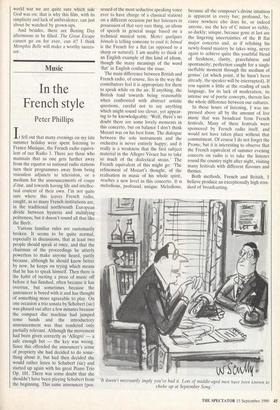Cinema
Memphis Belle ('12',Warner West End)
One for the boys
Hilary Mantel
These are the days of the blue funk and the dried egg, of the holy medal, the cigarette behind the ear; days of common purpose and fire in the sky. It is the summer of 1943, and the crew of the Memphis Belle, a B-17 'Flying Fortress', is about to complete its tour of duty. The boys have flown 24 missions unscathed, and if they can survive a 25th they will be 'wined, womened and songed from one end of the States to the other'. They will be part of a vast publicity scheme to promote the sale of war bonds and also reassure the American public, frightened by reports of casualties from Europe.
The film is inspired by William Wyler's 1944 documentary of the same name; Wyler's daughter Catherine is co-producer with David Puttnam. Puttnam wanted to
make a film about a British crew, but he could not find the finance for that. His ten flyers are all-American boys, played by a competent collection of young actors and introduced to us within the first minute of the film with a kind of weary acknowledg- ment that we have seen this kind of thing before: `. . . there's always a religious one . . . there's always one from Cleveland'. Director Michael Caton-Jones (of Scandal fame) has set out to produce a simulacrum of the kind of feel-good action drama that packed them in on a Saturday night, but also to interpret that particular style of movie-making for a generation of film- goers to whom the second world war is a distant historical event. The best way to enjoy this film is to borrow a couple of 12-year-old boys for the occasion. Twelve- year-old girls would probably find it in- sufficiently sophisticated. But what it lacks in subtlety it makes up in energy.
Events are concentrated into 24 hours, and confined to the air base from which a bombing raid on Bremen is to be launched. There is the scene-setting dance the night before the raid, in which tensions and squabbles among the crew are portrayed; next day, their individual characteristics will merge into the fighting unit, and these very ordinary, very young men will become heroes. I was not taken by the pilot's moonlit apostrophe to the Memphis Belle herself, the coy lass in her scanties who decorates the side of the plane; I thought, too, that the airman who reads a .Yeats poem (and pretends to have written it) was an unlikely character. But the action sequ- ences are exciting, and convincing to my inexpert eye. The hardware is the star of the show. The original Memphis Belle is now on display in Tennessee, but flyable models were found in the USA, Britain and France, together with eight Mustangs, the small planes which would escort the bombers until their limited fuel required a return to base. Veterans were brought in to advise the film-makers and the tense, cramped conditions on board are faithfully recreated. Somehow, though, the air battle is never quite as heart-stopping as it should be. This is a true story, and we know the boys will come through, no matter what disasters take place around them.
Heartstrings are tugged vigorously throughout. One of the flyers has a faithful dawg: and when, mission completed, the Memphis Belle staggers in, flying on one engine, towards its emergency landing, it is the faithful dawg who is the first to hear it, and alert the white-knuckled comrades below with a gladsome twitch of his ears. He twitches his ears, moreover, to the strains of 'Danny Boy': and earlier, the plane was fuelled and the bombs loaded to the tune of 'Amazing Grace'. You can imagine the heavy ironies that would be perceived if a hymn tune backed a similar sequence in a film about any more recent war. When we look back to the second
world war we are quite sure which side God was on; that is why this film, with its simplicity and lack of ambivalence, can just about be watched by grown-ups.
And besides, there are Boxing Day afternoons to be filled. The Great Escape cannot go on for ever, can it? I think Memphis Belle will make a worthy succes- sor.



























































 Previous page
Previous page